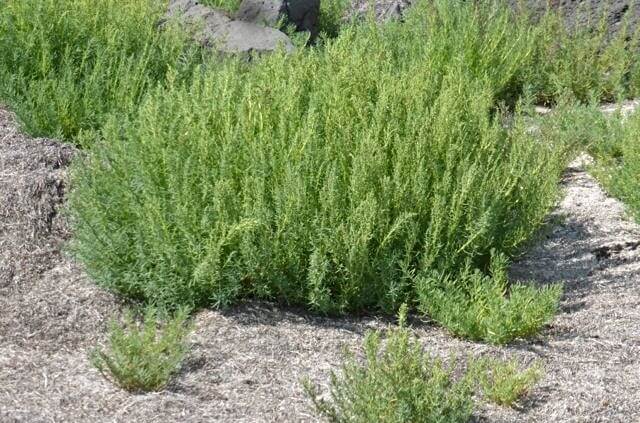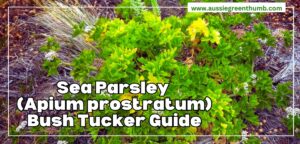Seablite is an incredible plant for foragers and elevates any bush tucker meal to a culinary masterpiece. Get to know how to spot, when to pick, and how to grow seablite in this concise bush tucker guide.
More...
Family: | Amaranthaceae |
|---|---|
Genus: | Suaeda |
Species: | S. australis |
Common names: | Seablite, Austral seablite, Redweed |
Origin: | Australia |
Location: | Outdoor |
Type: | Shrub, Bush Tucker |
Growth: | 90cm spread, 10cm tall |
Sun requirements: | Full sun |
Foliage colour: | Glaucous |
Flower colour: | Red |
Flowering: | Summer |
Edible parts: | Leaves and stems |
Maintenance level: | High |
Poisonous for pets: | Not toxic to pets |
What is Seablite?

Source: Friends of Williamstown Wetlands
Native Seablite, also called austral seablite, is the common name for a popular bush tucker plant in the genus Suaeda. It is an annual, coastal, succulent plant, found most typically in mangroves, requiring saline soil and water to thrive.
It often grows in huge swathes of saline wetlands and can be easily harvested once tidal or seasonal waters drop away.
As a food crop, its primary flavour is salt, but like samphire and other edible coastal leaves, it also has a vegetal zestiness.
Identifying Seablite
Seablite is often described as a shrub, due to its fast-growing nature, upright stems, and red or russet flowers that stipple its mangrove habitat in summer. It is, in fact, a short-lived herbaceous perennial.
In the wild, it is easiest to identify when found in large numbers but it is worth getting to know the more detailed characteristics too.
Seablite has dark green leaves that are glaucous when they first emerge, and fade to red as they mature, leading to a distinct ombré from red on the lower leaves to blue-green at their tips.
The succulent leaves are long, lanceolate forms, growing in symmetrical pairs, alternating at 90 degrees up the stem.
The flowers, which are edible too, are densely packed between upper leaves forming pinky-red clusters that look sort of like a dwarfed amaranth.
Common Uses of Seablite
Seablite is most commonly eaten fresh in salads, but can also be pickled in a simple vinegar and spice mix.
It is incredibly nutritious, but also very potently flavoured, so use it sparingly as a seasoning regardless of how it is prepared.
How to Grow Seablite
Seablite is a succulent shrub, usually grown as an annual or short lived perennial. It is a member of the amaranth family and flowers equally profusely, with thousands of seeds per season, distributed into ideal conditions, and fertilised with the composted materials of its parent plant, along with abundant nutrients and minerals from the seawater that wets its soil.
Soil Conditions & Location
If you’re growing your own seablite, it's not as simple as growing other succulents. They need salt to grow. That makes them a little trickier than your usual succulent shrubs, rockery or hedging plants.


Get Your Free Guide:
Master Growing Australian Natives eBook
A Must Have Complete Guide for Every Australian Garden
Get Your Free Guide:
Master Growing Australian Natives eBook
A Must Have Complete Guide for Every Australian Garden
If you live in a coastal area, sea blite can be grown on any ground that is irrigated by seawater.
If you live inland, you can create the conditions for growing seablite as an annual by preparing your own seaweed compost.
How to Make Seaweed Compost for Seablite:
The principle of seaweed compost for coastal plants, particularly salt marsh or mangrove plants, is to match salinity and mineral content with drainage.
Before starting, you will need to compost your seaweed. Start by drilling holes in the sides of a barrel, bucket or water butt. Fill the container with chopped up seaweed, and raise it up off the ground. Leave a bucket beneath it to catch any water that drains (save the liquid, it's useful for watering later).
Turn the seaweed every week for two months.
Mixing a usable compost:
- Use equal parts horticultural grit, sandy topsoil and composted seaweed.
- The mix should be friable, but drain well. You want it to hold water so it can squeeze out like a sponge once saturated, but to dry out within a week.
How to Propagate Seablite
Propagate seablite from seed or cuttings. Seablite propagated from cuttings in early autumn can be grown on for next year’s crop. You will need to leave the cut stem to callous for 48 hours before dipping in rooting hormone, and planting into a gritty, saline soil, watered every few days once the previous water has drained completely.
To start seablite from seed, fill the pot it is to grow in with the seaweed compost noted above (I like to use a long window box so the young plants don’t need to be disturbed or replanted).
Sow them any time between spring and late autumn, and keep the soil lightly moist until they are growing strongly, then irrigate regularly and allow water to drain fully as they establish.
Harvesting Seablite
Harvest wild seablite sparingly, and be considerate of the natural environment. Seablite is a salt marsh plant. In NSW, salt marshes are protected areas, and harvesting is not advised.
If you find seablite in wet coastal pockets, or in its occasional home in free-draining rocky slopes, it is safe to harvest without disturbing its ecosystem.
If you require seablite in large quantities, grow your own using the methods above.
Which parts of Seablite to harvest, and how to store it
Seablite leaves and flowers can both be eaten, and the stems are safe to consume, though not as tender, or pleasant. Cut off the younger sections of growth from seablite plants, taking about 15-20 cm of stem, back to a pair of leaves where the plant can easily regenerate.
Strip the leaves from the stem, and use them straight away, or pickle them for longer storage.
Wrapping Up Our Seablite Guide
Seablite isn’t easy to grow, and pretty much all of the commercial growers grow it in its natural conditions or replace it on mass. At home, it's a more experimental method, but worth trying.
Regardless of growing your own, you should absolutely get to know seablite as a forage crop, because seablite as a bush tucker food is spectacular.
Published on October 4, 2025 by Nathan Schwartz
Last Updated on October 4, 2025





